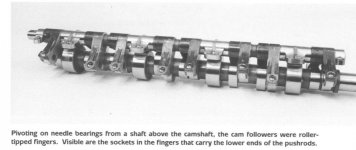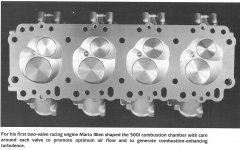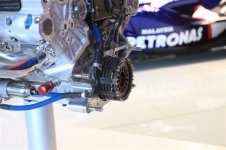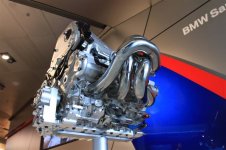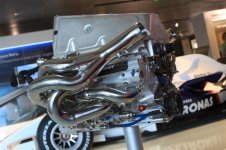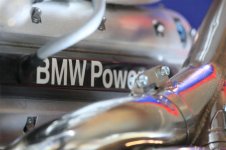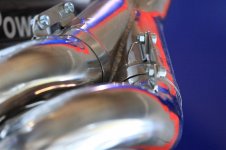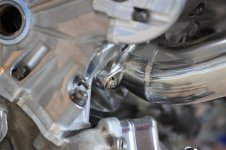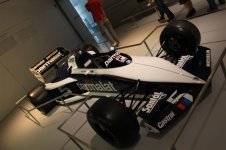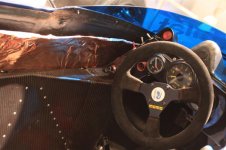Headlines
You are using an out of date browser. It may not display this or other websites correctly.
You should upgrade or use an alternative browser.
You should upgrade or use an alternative browser.
F1 engine technology
- Thread starter boostbros
- Start date
Steve Miklos
Charter Member / Competitor
I remember Smokey's attampts with that rule. He claimed it about killed him!
Steve
Steve
DONZI
New member
RRRRRRRRRRPM'S
http://www.youtube.com/watch?v=xyWP7mC1oX0
http://www.youtube.com/watch?v=xyWP7mC1oX0
C_Spray
Charter Member
RMBUILDER - Wow, those pictures bring back memories. We worked SOOOO hard to keep the whole project a secret for the 7 months it took to develop it that it's weird (even now) to see pictures of the valvetrain published. Uber-secret $hit, that stuff was....
I have a set of upper and lower rockers, a pushrod and a piston on my desk. I'll have to get some shots of them when I get back next week. By using the lower rockers, we were able to reduce both the length and the forces on the pushrods, allowing us to make them even lighter. The rockers had far less inertia than conventional lifters as well, all helping to reduce the valve spring load and rate requirements. The pushrods were made of a special steel alloy that expanded at the same rate as the aluminum block and heads, so you could set the valve lash when the engine was cold and it would not change at operating temperature. All lash adjustment was done with various thickness lash caps that fit on top of the valves, thereby eliminating setcrews, locknuts, etc. Again - less inertia, fewer parts, better packaging.
All the lower rockers, spacers and mounting blocks were fitted to the follower shaft in sequence, hand-packed with individual needles (no cages) and then the ends were electron-beam welded in place. The entire assembly was a non-serviceable, one-shot deal; we threw them away once they were mileaged out. The same was true with follower rollers on the lower rockers and the tip rollers on the upper rockers: hand-assembled with individual needles, the shafts inserted and electron-beam welded in place. Once and done. To this day, I remember: "1,280 1mm by 12mm needles per engine". So much attention was paid to reducing friction in the valve train that the engine guys had to install (and remove) the upper rockers in a certain sequence with the engine rotated to a specific position. If you got it wrong, the valve springs would actually spin the engine over, and it would spray oil freakin' e-v-e-r-y-w-h-e-r-e! (Ask me how we found out....)
The ports in the head were awesome: 100% round and 100% straight into the chamber. When you took the top off of the intake plenum and opened the throttle butterflies, you could see the entire top of the intake valve. The airflow numbers were (to say the least!) very, very good.
DONZI - We had to do all of our endurance testing on the racetrack, through one of the worst winters for snow ever in the NE. At one point, we had to get equipment from the Allentown airport to clear off the track at Nazareth. The very next year, we built a second, "simulation" dyno like the Honda one in your video. I would have killed to have that in 1994. We ran a 24/7 program, where then engine guys would come in and rebuild a test engine overnight and dyno it at 5:00 AM. The car guys would come in at 6:00 AM, put it in the car (still hot from the dyno), and we would load it in the truck and leave for Nazareth by 9:00 AM. We'd test from 11:00 AM until 5:00 PM (earlier if it failed), be back at the shop at 7:00 PM, deliver the engine to the engine shop by 8:00 PM, and start the process all over again. After all was said and done, we went to Indy and ran the entire month without blowing up a single engine - not one. We have never done that, before or since.
Miklos is right - Smokey wasn't the only one these engines damn near killed. But, Holy Mother Of God, did that thing run! (The fact that there are TWO injectors per cylinder should give you a clue....)
I have a set of upper and lower rockers, a pushrod and a piston on my desk. I'll have to get some shots of them when I get back next week. By using the lower rockers, we were able to reduce both the length and the forces on the pushrods, allowing us to make them even lighter. The rockers had far less inertia than conventional lifters as well, all helping to reduce the valve spring load and rate requirements. The pushrods were made of a special steel alloy that expanded at the same rate as the aluminum block and heads, so you could set the valve lash when the engine was cold and it would not change at operating temperature. All lash adjustment was done with various thickness lash caps that fit on top of the valves, thereby eliminating setcrews, locknuts, etc. Again - less inertia, fewer parts, better packaging.
All the lower rockers, spacers and mounting blocks were fitted to the follower shaft in sequence, hand-packed with individual needles (no cages) and then the ends were electron-beam welded in place. The entire assembly was a non-serviceable, one-shot deal; we threw them away once they were mileaged out. The same was true with follower rollers on the lower rockers and the tip rollers on the upper rockers: hand-assembled with individual needles, the shafts inserted and electron-beam welded in place. Once and done. To this day, I remember: "1,280 1mm by 12mm needles per engine". So much attention was paid to reducing friction in the valve train that the engine guys had to install (and remove) the upper rockers in a certain sequence with the engine rotated to a specific position. If you got it wrong, the valve springs would actually spin the engine over, and it would spray oil freakin' e-v-e-r-y-w-h-e-r-e! (Ask me how we found out....)
The ports in the head were awesome: 100% round and 100% straight into the chamber. When you took the top off of the intake plenum and opened the throttle butterflies, you could see the entire top of the intake valve. The airflow numbers were (to say the least!) very, very good.
DONZI - We had to do all of our endurance testing on the racetrack, through one of the worst winters for snow ever in the NE. At one point, we had to get equipment from the Allentown airport to clear off the track at Nazareth. The very next year, we built a second, "simulation" dyno like the Honda one in your video. I would have killed to have that in 1994. We ran a 24/7 program, where then engine guys would come in and rebuild a test engine overnight and dyno it at 5:00 AM. The car guys would come in at 6:00 AM, put it in the car (still hot from the dyno), and we would load it in the truck and leave for Nazareth by 9:00 AM. We'd test from 11:00 AM until 5:00 PM (earlier if it failed), be back at the shop at 7:00 PM, deliver the engine to the engine shop by 8:00 PM, and start the process all over again. After all was said and done, we went to Indy and ran the entire month without blowing up a single engine - not one. We have never done that, before or since.
Miklos is right - Smokey wasn't the only one these engines damn near killed. But, Holy Mother Of God, did that thing run! (The fact that there are TWO injectors per cylinder should give you a clue....)
Uncle Dave
New member
Fantastic pics, and Information.
Elegant engineering and innovative solutions to problems like this gives me a woody.
Id die to have a large displacement version of that engine running pump gas available today.
Uncle Dave
Elegant engineering and innovative solutions to problems like this gives me a woody.
Id die to have a large displacement version of that engine running pump gas available today.
Uncle Dave
Wobble
Charter Member
The 1986 BMW f-1 engine was an incredible piece capable of better than 1300 hp for short bursts during qualifying
Season: 1986
Capacity: 1,499 cc
Cylinders: 4-cylinder in line
Bhp: 900
RPM: 11200
Watched that thing run back at Silverstone back in the day
Season: 1986
Capacity: 1,499 cc
Cylinders: 4-cylinder in line
Bhp: 900
RPM: 11200
Watched that thing run back at Silverstone back in the day
Attachments
Last edited:
Anchored
New member
RMBUILDER - Wow, those pictures bring back memories. We worked SOOOO hard to keep the whole project a secret for the 7 months it took to develop it that it's weird (even now) to see pictures of the valvetrain published. Uber-secret $hit, that stuff was....
I have a set of upper and lower rockers, a pushrod and a piston on my desk. I'll have to get some shots of them when I get back next week. By using the lower rockers, we were able to reduce both the length and the forces on the pushrods, allowing us to make them even lighter. The rockers had far less inertia than conventional lifters as well, all helping to reduce the valve spring load and rate requirements. The pushrods were made of a special steel alloy that expanded at the same rate as the aluminum block and heads, so you could set the valve lash when the engine was cold and it would not change at operating temperature. All lash adjustment was done with various thickness lash caps that fit on top of the valves, thereby eliminating setcrews, locknuts, etc. Again - less inertia, fewer parts, better packaging.
All the lower rockers, spacers and mounting blocks were fitted to the follower shaft in sequence, hand-packed with individual needles (no cages) and then the ends were electron-beam welded in place. The entire assembly was a non-serviceable, one-shot deal; we threw them away once they were mileaged out. The same was true with follower rollers on the lower rockers and the tip rollers on the upper rockers: hand-assembled with individual needles, the shafts inserted and electron-beam welded in place. Once and done. To this day, I remember: "1,280 1mm by 12mm needles per engine". So much attention was paid to reducing friction in the valve train that the engine guys had to install (and remove) the upper rockers in a certain sequence with the engine rotated to a specific position. If you got it wrong, the valve springs would actually spin the engine over, and it would spray oil freakin' e-v-e-r-y-w-h-e-r-e! (Ask me how we found out....)
The ports in the head were awesome: 100% round and 100% straight into the chamber. When you took the top off of the intake plenum and opened the throttle butterflies, you could see the entire top of the intake valve. The airflow numbers were (to say the least!) very, very good.
DONZI - We had to do all of our endurance testing on the racetrack, through one of the worst winters for snow ever in the NE. At one point, we had to get equipment from the Allentown airport to clear off the track at Nazareth. The very next year, we built a second, "simulation" dyno like the Honda one in your video. I would have killed to have that in 1994. We ran a 24/7 program, where then engine guys would come in and rebuild a test engine overnight and dyno it at 5:00 AM. The car guys would come in at 6:00 AM, put it in the car (still hot from the dyno), and we would load it in the truck and leave for Nazareth by 9:00 AM. We'd test from 11:00 AM until 5:00 PM (earlier if it failed), be back at the shop at 7:00 PM, deliver the engine to the engine shop by 8:00 PM, and start the process all over again. After all was said and done, we went to Indy and ran the entire month without blowing up a single engine - not one. We have never done that, before or since.
Miklos is right - Smokey wasn't the only one these engines damn near killed. But, Holy Mother Of God, did that thing run! (The fact that there are TWO injectors per cylinder should give you a clue....)
Was that engine developed in Brixworth or just the testing?
I've worked with the bloke that ran the test bench.
Jeff
C_Spray
Charter Member
SpinTron testing and the initial development dyno runs were made in the UK. Once we started track-testing the engine in late February, I believe that we did all the dyno work over here in the Penske engine shop.Was that engine developed in Brixworth or just the testing?
I've worked with the bloke that ran the test bench.
Jeff
Some of it was scary - The dyno cell exhaust fans were marginal (designed to handle up to 800-900 hp), so during long power pulls enough fumes could build up that they would detonate and blow out all the ceiling tiles. There would be a big "whump" out in the car shops when that happened. The dyno guys' ears would pop like they were on a plane.
I'm with Uncle Dave - a 550 cubic inch version of that engine would probably make roughly 1,400 hp (at 9,800 rpm...) on methanol with no blower. :ack2: Don't know what it would do on gas; maybe 1,100-1,200??
The late Gary Garbrecht wanted to attack the 7-liter hydro record in the late 90's and asked about "borrowing" two of the engines, which would total 418 cubic inches. He would have had 1,960 hp to work with. Don't think anyone ever got that out of a 427 Chevy...
MikeyFIN
Competitor
The 1986 BMW f-1 engine was an incredible piece capable of better than 1300 hp for short bursts during qualifying
Season: 1986
Capacity: 1,499 cc
Cylinders: 4-cylinder in line
Bhp: 900
RPM: 11200
Watched that thing run back at Silverstone back in the day
Seen that sucker run last a year ago...
MikeyFIN
Competitor
The late Gary Garbrecht wanted to attack the 7-liter hydro record in the late 90's and asked about "borrowing" two of the engines, which would total 418 cubic inches. He would have had 1,960 hp to work with. Don't think anyone ever got that out of a 427 Chevy...
Well Actually Daytona Marines Scarab427 was at 600+ with a Turbo back in 66 and there has been 1800hp Streetcars with Turbos done by Monty Williams So In my opinion there´s not a substitute for cubic inches.
Similar threads
- Replies
- 0
- Views
- 4K
- Replies
- 3
- Views
- 3K



